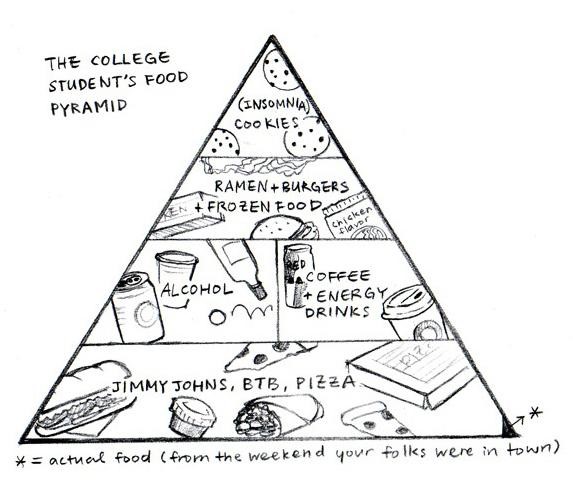There are many actions that college students can take to eat more healthily and enjoy their college years without jeopardizing their health from excessive weight gain or weight loss.
Among some recommendations are:
Try to get at least eight hours of sleep a night. Avoid skipping meals. When you skip a meal, the subsequent hunger may cause you to overeat. Also, getting 8hrs of sleep a night improves your metabolism.
Eat breakfast, which helps concentration and increases the likelihood of consuming calcium, folic acid, and vitamin C. These nutrients are often low in the diet of college students. But please, not doughnuts or muffins or such. Try to get a decent combination of protein, carbs, and fats.
Manage portion sizes. If you underestimate portion sizes, you may eat more calories than are needed. Also, the availability of a wide variety and mass quantities of “dorm” food (pizza, soda, etc.) may promote overeating and a significant increase in total energy intake. Actually, can we convince you to skip soda altogether? Soda is full of useless calories and excessive amounts of sugar.
Drink water and eat fruit throughout the day. Water is calorie-free, and fruits help manage urges to eat and contribute fiber, vitamins, and minerals.
Exercise regularly. Physical activity helps burn off calories, helps manage stress, and promotes mental and physical stamina.
When students first enter college, their diets often deteriorate, and they often gain excess weight (primarily fat). There are many factors responsible for these changes. Ultimately, however, in most cases, weight/fat gain is related to taking in more calories than using. There are also several measures that can you can take to avoid the fat gain and decline in food quality that typically occurs during the college years.
The term “freshman 15” refers to the number of pounds of fat that too many students gain during their first year in college. This weight gain is related to partying (alcohol and fast food), a sedentary lifestyle, and changes in food intake and diet patterns, and occurs in colleges all over the world. Something to note, alcohol suppresses your metabolism. Drinking beer and eating pizza tends to have a negative effect on people over time.

Also, college students frequently skip meals and rarely observe management of weight and food intake. Class and work schedules change daily, as well as every semester. It can be difficult, no doubt. However, regular eating patterns help students’ academic performance. Here are some suggestions:
Become familiar with the campus environment and the foods that are available.
Most colleges and universities have a variety of eateries, each with a different format, theme, and food options. Those options range from healthy to non-healthy. Find your balance.
Try the low-calorie, low-sugar, and vegetarian options almost universally available around campus. As part of a well-planned diet, these items can help manage total energy intake and introduce one or two items that can become part of a regular diet.
Keep low-calorie snacks in the dorm room. It will help manage calorie intake when snacking, especially when eating late at night. These snacks should consist of decent protein bars, fruit, and cheese sticks. All can be found on campus or at nearby drugstores.
Lifestyle changes, peer pressure, limited finances, and access to food also contribute to erratic eating patterns. College students have little variety in their diet and often turn to easy-to-obtain, tasty, high-fat snacks. Adding to the issue is manufactures confusing labels about serving sizes often results in students eating more than they think they are eating.

Of the three nutrients that provide calories (carbohydrates, proteins, and fats), carbohydrate (particularly sugar) and fat intake often far exceed recommended levels. College students also tend to have a low intake of dietary fiber, which frequently leads to unhealthy eating and digestive issues.
Despite these difficulties, it is important for students to find time for nutritious and varied foods. Regarding vitamins, a low vitamin C status has been associated with college students’ low intake of fruits and vegetables (with levels of vitamin C being even lower among kids that smoke). Regarding minerals, calcium, iron, and zinc intake are low, while sodium intake is higher than recommended.
Male college students are more likely to meet dietary intake recommendations for the meat, poultry, fish, dry beans, and nuts group; from the bread, cereal, rice, and pasta group; and from the vegetable food group than are females.
Males seem to consume more food overall and thus have higher energy (calorie) intakes. Female college students tend to eat too many breads, grains, and dairy products. College students frequently consume alcoholic beverages, further impairing the quality of their diet.
Eating disorders such as anorexia and bulimia are popular amongst college females than among the general population. These disorders are related to body image dissatisfaction—dysmorphic -females that are underweight, as measured by their body mass index (BMI), sometimes consider themselves overweight. The incidence of anorexia and bulimia may increase when there is an excessive preoccupation with weight, academic achievement, body image, and eating, as well as during stressful periods, such as final exams.
The prevalence of disordered eating is surprisingly high among athletes. College athletes may manipulate diet and fluid intake, putting their health at risk given their physical activity level.
They may also jeopardize their health by taking excessive amounts of questionable supplements because of misinformation, or of pressure from coaches or peers. Athletes may feel pressured to restrict their food intake if they are on an athletic scholarship or competing in weight-classification sports such as wrestling.
Female athletes may be underweight or have an extremely low amount of body fat. Most universities have regular or optional meal plans, which provide access to campus food for a flat rate. Per meal, these plans can be a good value and provide access to multiple food resources.
Universities can also take a variety of steps to promote healthful food behaviors. Campus and residence hall wellness programs provide students with information and point-of-purchase information at dining halls can help students make on-the-spot decisions that support healthy choices.
College students will likely eat healthful foods if they are available and convenient. Making protein bars, fruits, and other healthy options readily available on campus would greatly increase the health of young American students.
Tell us what you think.
How do you avoid the Freshman 15?








